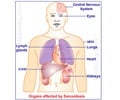Controlled oxygen therapy could reduce deaths in lung disease patients, according to research conducted by Menzies Research Institute Tasmania (Menzies).

COPD is a chronic lung disease that affects over 200 million people worldwide.
It is estimated up to one in six people over the age of 45 are living with COPD and it is now the fourth largest killer of Australians.
COPD is a chronic lung disease characterised by partial obstruction in the airway tubes which results in breathing difficulties. It is a progressive, disabling and potentially fatal disease.
Unlike asthma, COPD is not reversible with medications and it is most commonly found in people who have smoked cigarettes or been exposed to airborne irritants.
Menzies’ researchers have found the risk of death in patients with COPD was significantly reduced by using controlled oxygen therapy instead of the standard approach of high concentration levels of oxygen.
Advertisement
“Giving high concentration oxygen to patients with COPD, however, can lead to a build up of carbon dioxide in the blood, which can lead to respiratory failure,” Associate Professor Wood-Baker said.
Advertisement
Overall, controlled oxygen therapy reduced the risk of death from respiratory failure by 58 per cent for all patients and 78 per cent for confirmed COPD patients compared to high concentration oxygen therapy.
First author and chief investigator, Dr Mike Austin, says the findings provide the first high quality evidence from a randomised controlled trial for the development of new universal guidelines on oxygen therapy for patients with chronic lung disease.
This research supports the British Thoracic Society’s 2008 guidelines on acute oxygen treatment which recommends oxygen should be administered only at levels sufficient to maintain adequate oxygen saturations,” Dr Austin said.
“These guidelines where implemented by the UK ambulance service in 2009.”
“Oxygen therapy should only be given in specific circumstances in which the benefits outweigh the risks, and the patient’s response to the therapy must be closely monitored,” he said.
This new study has been published online in the prestigious British Medical Journal (BMJ). Funding bodies that supported this COPD research include the Australian College of Ambulance Professionals (ACAP). Walkie nebulization air compressors were donated by FlaemNo
Source-Medindia











